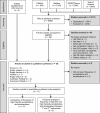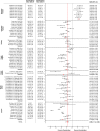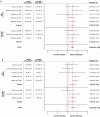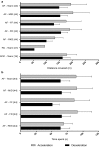High-Intensity Acceleration and Deceleration Demands in Elite Team Sports Competitive Match Play: A Systematic Review and Meta-Analysis of Observational Studies
- PMID: 31506901
- PMCID: PMC6851047
- DOI: 10.1007/s40279-019-01170-1
High-Intensity Acceleration and Deceleration Demands in Elite Team Sports Competitive Match Play: A Systematic Review and Meta-Analysis of Observational Studies
Abstract
Background: The external movement loads imposed on players during competitive team sports are commonly measured using global positioning system devices. Information gleaned from analyses is employed to calibrate physical conditioning and injury prevention strategies with the external loads imposed during match play. Intense accelerations and decelerations are considered particularly important indicators of external load. However, to date, no prior meta-analysis has compared high and very high intensity acceleration and deceleration demands in elite team sports during competitive match play.
Objective: The objective of this systematic review and meta-analysis was to quantify and compare high and very high intensity acceleration vs. deceleration demands occurring during competitive match play in elite team sport contexts.
Methods: A systematic review of four electronic databases (CINAHL, MEDLINE, SPORTDiscus, Web of Science) was conducted to identify peer-reviewed articles published between January 2010 and April 2018 that had reported higher intensity (> 2.5 m·s-2) accelerations and decelerations concurrently in elite team sports competitive match play. A Boolean search phrase was developed using key words synonymous to team sports (population), acceleration and deceleration (comparators) and match play (outcome). Articles only eligible for meta-analysis were those that reported either or both high (> 2.5 m·s-2) and very high (> 3.5 m·s-2) intensity accelerations and decelerations concurrently using global positioning system devices (sampling rate: ≥ 5 Hz) during elite able-bodied (mean age: ≥ 18 years) team sports competitive match play (match time: ≥ 75%). Separate inverse random-effects meta-analyses were conducted to compare: (1) standardised mean differences (SMDs) in the frequency of high and very high intensity accelerations and decelerations occurring during match play, and (2) SMDs of temporal changes in high and very high intensity accelerations and decelerations across first and second half periods of match play. Using recent guidelines recommended for the collection, processing and reporting of global positioning system data, a checklist was produced to help inform a judgement about the methodological limitations (risk of detection bias) aligned to 'data collection', 'data processing' and 'normative profile' for each eligible study. For each study, each outcome was rated as either 'low', 'unclear' or 'high' risk of bias.
Results: A total of 19 studies met the eligibility criteria, comprising seven team sports including American Football (n = 1), Australian Football (n = 2), hockey (n = 1), rugby league (n = 4), rugby sevens (n = 3), rugby union (n = 2) and soccer (n = 6) with a total of 469 male participants (mean age: 18-29 years). Analysis showed only American Football reported a greater frequency of high (SMD = 1.26; 95% confidence interval [CI] 1.06-1.43) and very high (SMD = 0.19; 95% CI - 0.42 to 0.80) intensity accelerations compared to decelerations. All other sports had a greater frequency of high and very high intensity decelerations compared to accelerations, with soccer demonstrating the greatest difference for both the high (SMD = - 1.74; 95% CI - 1.28 to - 2.21) and very high (SMD = - 3.19; 95% CI - 2.05 to - 4.33) intensity categories. When examining the temporal changes from the first to the second half periods of match play, there was a small decrease in both the frequency of high and very high intensity accelerations (SMD = 0.50 and 0.49, respectively) and decelerations (SMD = 0.42 and 0.46, respectively). The greatest risk of bias (40% 'high' risk of bias) observed across studies was in the 'data collection' procedures. The lowest risk of bias (35% 'low' risk of bias) was found in the development of a 'normative profile'.
Conclusions: To ensure that elite players are optimally prepared for the high-intensity accelerations and decelerations imposed during competitive match play, it is imperative that players are exposed to comparable demands under controlled training conditions. The results of this meta-analysis, accordingly, can inform practical training designs. Finally, guidelines and recommendations for conducting future research, using global positioning system devices, are suggested.
Conflict of interest statement
Damian Harper, Chris Carling and John Kiely have no conflicts of interests that are directly relevant to the content of this article.
Figures






Similar articles
-
Application of Global Positioning System and Microsensor Technology in Competitive Rugby League Match-Play: A Systematic Review and Meta-analysis.Sports Med. 2016 Apr;46(4):559-88. doi: 10.1007/s40279-015-0440-6. Sports Med. 2016. PMID: 26714810
-
The Effect of High-Intensity Accelerations and Decelerations on Match Outcome of an Elite English League Two Football Team.Int J Environ Res Public Health. 2021 Sep 21;18(18):9913. doi: 10.3390/ijerph18189913. Int J Environ Res Public Health. 2021. PMID: 34574836 Free PMC article.
-
Movement Demands of Elite Under-20s and Senior International Rugby Union Players.PLoS One. 2016 Nov 8;11(11):e0164990. doi: 10.1371/journal.pone.0164990. eCollection 2016. PLoS One. 2016. PMID: 27824865 Free PMC article.
-
High-Intensity Accelerations and Decelerations During Intercounty Camogie Match Play.Sports Health. 2025 Jan-Feb;17(1):66-79. doi: 10.1177/19417381241276016. Epub 2024 Sep 4. Sports Health. 2025. PMID: 39233437 Free PMC article.
-
Activity Demands During Multi-Directional Team Sports: A Systematic Review.Sports Med. 2017 Dec;47(12):2533-2551. doi: 10.1007/s40279-017-0772-5. Sports Med. 2017. PMID: 28801751
Cited by
-
Contextualised physical metrics: The physical demands vary with phase of play during elite soccer match play.Eur J Sport Sci. 2024 Nov;24(11):1627-1638. doi: 10.1002/ejsc.12209. Epub 2024 Oct 27. Eur J Sport Sci. 2024. PMID: 39462989 Free PMC article.
-
Individual In-Situ GPS-Derived Acceleration-Speed Profiling: Toward Automatization and Refinement in Male Professional Rugby Union Players.Sports Med Open. 2024 Jan 11;10(1):6. doi: 10.1186/s40798-023-00672-7. Sports Med Open. 2024. PMID: 38206549 Free PMC article.
-
Sports Injuries of a Portuguese Professional Football Team during Three Consecutive Seasons.Int J Environ Res Public Health. 2022 Oct 2;19(19):12582. doi: 10.3390/ijerph191912582. Int J Environ Res Public Health. 2022. PMID: 36231882 Free PMC article.
-
Match Analysis in Team Ball Sports: An Umbrella Review of Systematic Reviews and Meta-Analyses.Sports Med Open. 2022 May 13;8(1):66. doi: 10.1186/s40798-022-00454-7. Sports Med Open. 2022. PMID: 35553279 Free PMC article.
-
Blood Biomarkers Variations across the Pre-Season and Interactions with Training Load: A Study in Professional Soccer Players.J Clin Med. 2021 Nov 27;10(23):5576. doi: 10.3390/jcm10235576. J Clin Med. 2021. PMID: 34884288 Free PMC article.
References
-
- Aughey RJ. Widening margin in activity profile between elite and sub-elite Australian football: a case study. J Sci Med Sport. 2013;16:382–386. - PubMed
-
- Bradley PS, Archer DT, Hogg B, Schuth G, Bush M, Carling C, et al. Tier-specific evolution of match performance characteristics in the English Premier League: it’s getting tougher at the top. J Sports Sci. 2016;34:980–987. - PubMed
-
- Barnes C, Archer DT, Hogg B, Bush M, Bradley PS. The evolution of physical and technical performance parameters in the English Premier League. Int J Sports Med. 2014;35:1095–1100. - PubMed
-
- Bradley PS, Carling C, Gomez Diaz A, Hood P, Barnes C, Ade J, et al. Match performance and physical capacity of players in the top three competitive standards of English professional soccer. Hum Mov Sci. 2013;32:808–821. - PubMed
-
- Vanrenterghem J, Nedergaard NJ, Robinson MA, Drust B. Training load monitoring in team sports: a novel framework separating physiological and biomechanical load-adaptation pathways. Sports Med. 2017;47:2135–2142. - PubMed
Publication types
MeSH terms
LinkOut - more resources
Full Text Sources
Miscellaneous

